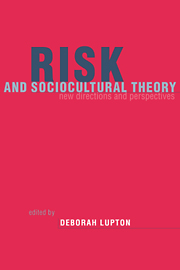Book contents
- Frontmatter
- Contents
- List of contributors
- Introduction: risk and sociocultural theory
- 1 Postmodern reflections on ‘risk’, ‘hazards’ and life choices
- 2 Fear of crime and the media: sociocultural theories of risk
- 3 Risk and the ontology of pregnant embodiment
- 4 Risk anxiety and the social construction of childhood
- 5 Constructing an endangered nation: risk, race and rationality in Australia's native title debate
- 6 Risk, calculable and incalculable
- 7 Ordering risks
- Index
1 - Postmodern reflections on ‘risk’, ‘hazards’ and life choices
Published online by Cambridge University Press: 16 September 2009
- Frontmatter
- Contents
- List of contributors
- Introduction: risk and sociocultural theory
- 1 Postmodern reflections on ‘risk’, ‘hazards’ and life choices
- 2 Fear of crime and the media: sociocultural theories of risk
- 3 Risk and the ontology of pregnant embodiment
- 4 Risk anxiety and the social construction of childhood
- 5 Constructing an endangered nation: risk, race and rationality in Australia's native title debate
- 6 Risk, calculable and incalculable
- 7 Ordering risks
- Index
Summary
Introduction: risk, hazards and modernity
Before the era of modernity, risk was a neutral term, concerned merely with probabilities, with losses and gains. A gamble or an endeavour that was associated with high risk meant simply that there was great potential for significant loss or significant reward. However, in the modern period, risk has been co-opted as a term reserved for a negative or undesirable outcome, and as such, is synonymous with the terms danger or hazard. Thus the British Medical Association's (1987: 13) guide Living with Risk describes a hazard as ‘a set of circumstances which may cause harmful consequences’, while risk is ‘the likelihood of its doing so’. Furthermore, this hazard/risk differentiation introduces a moral dimension, such that the perpetrators of risk may be held to account in some way or other (Douglas, 1992: 22–5). This chapter explores this dichotomy, and develops a postmodern position that challenges more traditional readings.
The science of risk calculation, assessment and evaluation is emblematic of modernism and its commitments to progress through rationalization: from the actuarial tables of life insurers to the risk analysis of those in the business of risk: the movers and shakers of capitalism (Hassler, 1993). In what might almost be a handbook for such entrepreneurial activity, Johnstone-Bryden (1995: 1), in a monograph sub-titled How to Work Successfully with Risk, offers a blueprint for ‘how risks can be identified and reduced economically and effectively, before serious damage occurs’. Hertz and Thomas (1983: 1) describe risk analysis as methods which seek a ‘comprehensive understanding and awareness’ of the risks associated with a given setting.
- Type
- Chapter
- Information
- Risk and Sociocultural TheoryNew Directions and Perspectives, pp. 12 - 33Publisher: Cambridge University PressPrint publication year: 1999
- 54
- Cited by



